Employee recognition isn’t just a nice-to-have – it’s a crucial element of a thriving company culture. We’re diving into the world of rewards and recognition, where great work gets its due and employee engagement soars. As any seasoned HR pro will tell you, a well-crafted recognition program can transform your workplace. It’s not about grand gestures alone; it’s about creating an environment where team members feel appreciated daily. There are countless ways to give and receive recognition, from spontaneous shout-outs to structured awards. By integrating the right recognition tools and practices, you’re not just acknowledging achievements – you’re building a culture where success is celebrated, and employees are motivated to excel. Ready to revolutionize your approach to appreciation?
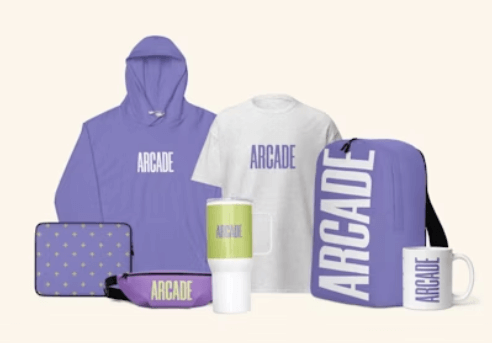
How SwagMagic can help your brand?
- Bulk Buy & Save on your gifts!
- Curate Customized Swag Boxes!
- Launch Your Store for your employees!
- Secure Swag Storage with us!
Table of contents
- What are Employee Rewards?
- What are the types of Employee Rewards?
- Why are Employee Rewards Important?
- When Should You Reward Employees?
- How to Implement an Effective & Successful Employee Reward System?
- Where Should You Reward Employees?
- Understanding Reward Motivation Theory and Psychology
- Reward Motivation Psychology
- Reward And Motivation Theory
- Difference Between Rewards and Recognition
- Employee Rewards and Recognition Programs
- Reward and Recognition Ideas For Employees To Boost Morale and Motivate
- How to Announce Employee Reward and Recognition at the Workplace
- Companies with Best Employee Rewards and Recognition Programs
- Best Reward and Recognition Platform Offering Employee Rewards Ideas and Employee Recognition Services
- Addressing Pain Points of Employee Rewards and Recognition with SwagMagic Offerings
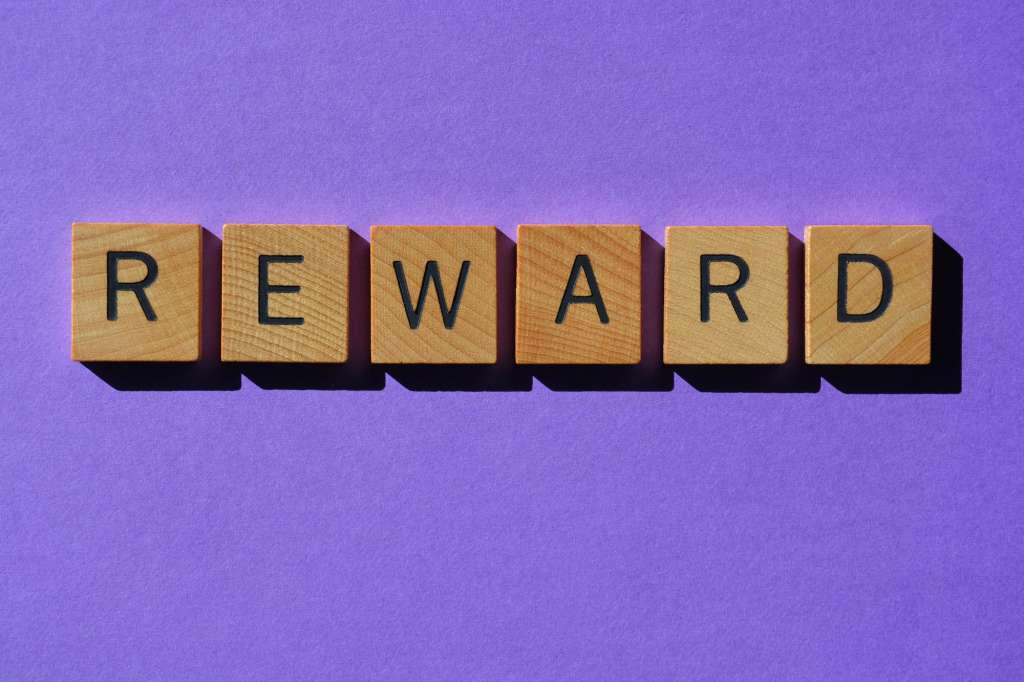
What are Employee Rewards?
Employee rewards are a powerful form of recognition that helps organizations acknowledge and celebrate their workforce’s efforts and achievements. These can manifest in various ways, from tangible perks like bonuses to intangible gestures like public praise. The key is ensuring employees feel appreciated through timely and meaningful recognition. Modern recognition software has made it easier to give recognition consistently and track its impact. When implementing a rewards system, it’s crucial to establish clear criteria for employee recognition, ensuring fairness and transparency. Whether it’s a simple expression of gratitude or a more substantial reward, the goal is to create a culture where employees know their contributions are valued. This boosts morale and encourages continued excellence and engagement in the workplace.
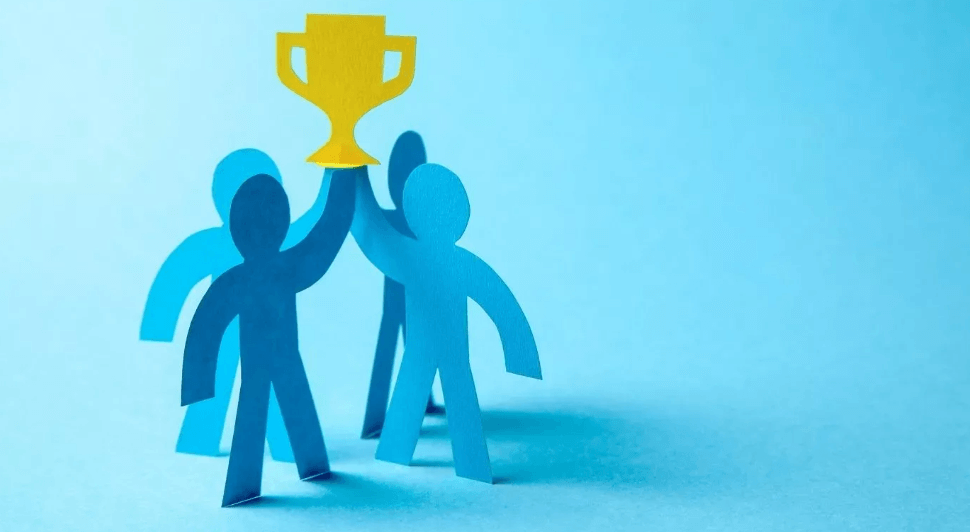
What are the types of Employee Rewards?
Employee rewards can be broadly classified into these groups:
Monetary rewards
Curate the perfect box of handpicked gift they’ll love and send joy their way
Monetary rewards include salary raises, bonuses, and stock options, which directly boost your employees’ earnings. These rewards are a powerful way to recognize and reward your employees’ hard work and dedication. Not only do they contribute to financial well-being, but they also enhance employee engagement and retention by showing that you value their contributions. Surveys often show that monetary rewards highly motivate employees and can lead to greater satisfaction and performance.
Non-monetary rewards
Non-monetary rewards, like appreciation gifts, thank-you swag, or extra vacation days, are crucial in employee recognition. These gestures can be as simple as handwritten thank-you notes or work-from-home snacks that show you care. Providing these rewards helps create a positive work environment and reinforces peer recognition. They are often redeemable for items or experiences that make employees feel valued and appreciated, boosting overall morale and job satisfaction.
Intrinsic rewards
Intrinsic rewards recognize the personal fulfillment employees gain from their work. This might include meaningful project assignments or opportunities to take on challenging roles. Employees who feel empowered and find intrinsic value in their work are likelier to stay engaged and committed. Regular recognition of their achievements and offering growth opportunities can help cultivate a strong sense of purpose and satisfaction.
Extrinsic rewards
Extrinsic rewards are tangible benefits like awards or public recognition. These rewards help employees feel recognized for their hard work and achievements. For example, employee-of-the-month awards or special perks can make employees feel valued and appreciated. Such rewards can drive engagement and foster a competitive yet supportive atmosphere within your team.
Employee incentives
Employee incentives are designed to motivate and reward employees for achieving specific goals or performance milestones. These might include performance bonuses, gift cards, or even special events. Incentives are a great way to encourage employees to strive for excellence and can effectively improve individual and team performance.
Wellness-based rewards
Wellness-based rewards focus on supporting employees’ overall health and well-being. These can include gym memberships, wellness programs, or mental health resources. Investing in these rewards shows that you care about your employees’ holistic health, which can enhance employee engagement and retention. It also empowers them to maintain a balanced and healthy lifestyle.
Career and development rewards
Career and development rewards include training programs, mentorship opportunities, and promotions. These rewards help employees grow and advance in their careers, demonstrating that you are invested in their professional development. Providing these opportunities motivates employees and helps in onboarding new talent and retaining top performers by offering them a clear path for growth and advancement.
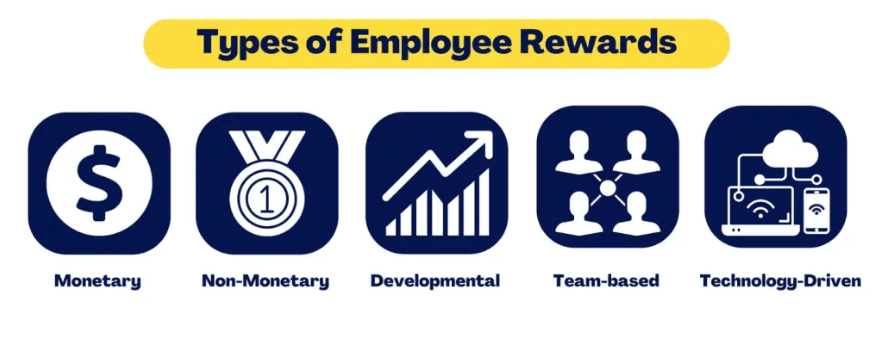
Why are Employee Rewards Important?
The employee rewards are important as they help us in:
Employee motivation
Employee rewards are crucial for boosting motivation. Rewarding your employees serves as a clear signal that their hard work is being noticed and valued. A well-timed reward can rejuvenate an employee’s enthusiasm and drive, encouraging them to maintain high performance. When employees feel recognized and appreciated, they are more likely to go above and beyond, contributing positively to their motivation and job satisfaction.
Attract and retain talent
Offering competitive rewards is key to attracting and retaining the best talent in the industry. When you give your employees compelling incentives and recognition, it sets your organization apart from others. Competitive rewards packages draw in top candidates and help retain existing employees by demonstrating that you value their contributions and are committed to their professional growth. This can create a strong employer brand that attracts talented individuals and keeps them engaged long-term.
Enhance productivity
Rewards play a significant role in enhancing productivity. When employees are recognized and rewarded, they are more likely to feel motivated to perform at their best. A culture that consistently acknowledges hard work and achievements can drive employees to be more productive and engaged. By giving every employee regular recognition and rewards, you foster an environment where productivity thrives, and individuals are driven to excel in their roles.
Builds a positive work culture
Regular rewards are instrumental in building a positive work culture. When you reward your employees, you promote a culture of appreciation and recognition. This environment encourages teamwork and collaboration, as employees feel valued and respected. Employees benefit from a culture where their contributions are acknowledged, improving morale and creating a more cohesive workplace atmosphere.
Encourage Employee Development
Providing rewards for personal and professional development shows that you value growth and learning. Rewarding employees for taking on new challenges or completing training programs motivates them to pursue further development opportunities. This helps in personal growth and enhances the overall skill set within the organization, contributing to a more knowledgeable and capable workforce.
Strengthen Employee Loyalty
Rewards also play a crucial role in fostering employee loyalty. When employees feel consistently valued and recognized, they are more likely to develop a sense of loyalty to the company. This can lead to lower turnover rates and a more committed workforce, as employees are motivated to stay with an organization that appreciates and rewards their contributions.
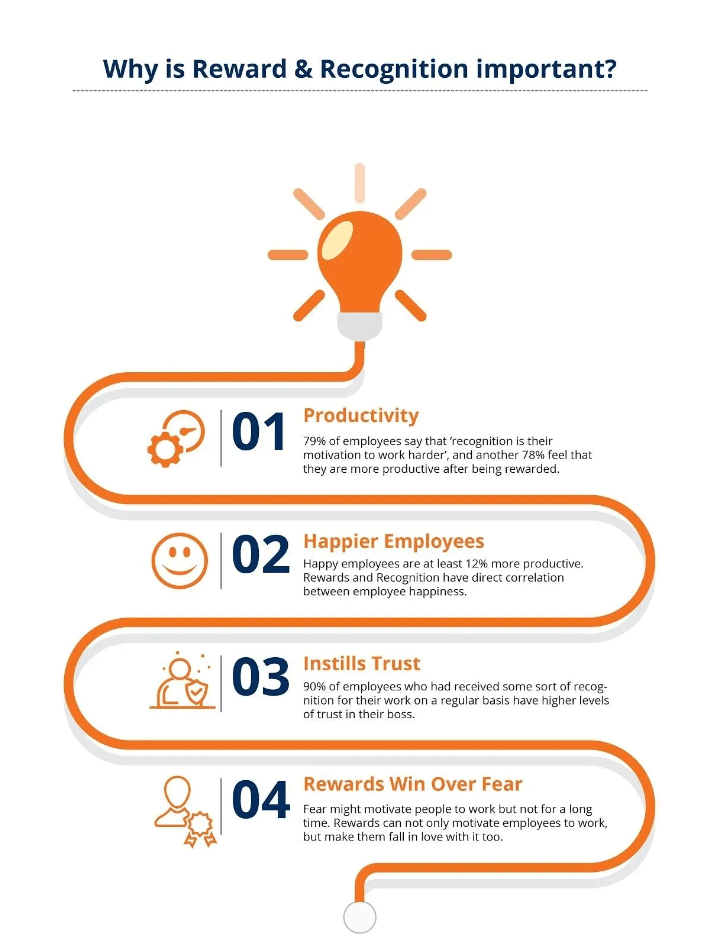
When Should You Reward Employees?
The timing of rewards plays a pivotal role in ensuring their effectiveness.
Scheduled rewards
Scheduled rewards, such as yearly bonuses or bi-annual pay raises, are given at predetermined intervals. These rewards help to acknowledge employees’ ongoing contributions and ensure they are recognized regularly for their hard work. Creating a program that includes these scheduled rewards shows employees that their consistent effort over time is valued and appreciated. It’s important to let them know their dedication is being recognized, which helps them stay motivated and engaged.
Unscheduled rewards
Unscheduled rewards are spontaneous and are given for exceptional performance or behavior that deserves immediate recognition. These rewards might include a shout-out during a company meeting or a token of appreciation that employees can redeem. Such rewards provide timely recognition, boost morale, and reinforce positive behaviors. Employees would feel that their job well done is acknowledged on the spot, creating a positive reinforcement loop that encourages continued high performance.
Milestone rewards
Milestone rewards are given when an employee reaches a significant tenure, like celebrating years of service or achieving a noteworthy accomplishment. These rewards are great for marking special occasions and recognizing long-term dedication or major achievements. Whether it’s a special gift, a recognition from peers, or a celebration event, these milestones help reinforce that employees’ hard work is part of the company culture. They are a way to show appreciation for both loyalty and exceptional performance, making employees feel valued and engaged.

How to Implement an Effective & Successful Employee Reward System?
Customization
Understand what motivates individual employees. Some might value monetary rewards, while others may appreciate flexible hours or additional training.
Transparency
Ensure that the rewards process is transparent. Everyone should know what they need to do to earn a reward.
Consistency
Stay consistent with how and when you reward. This ensures that rewards are given out fairly.
Feedback Loop
Allow employees to give feedback on the reward system. This helps in continuous improvement.
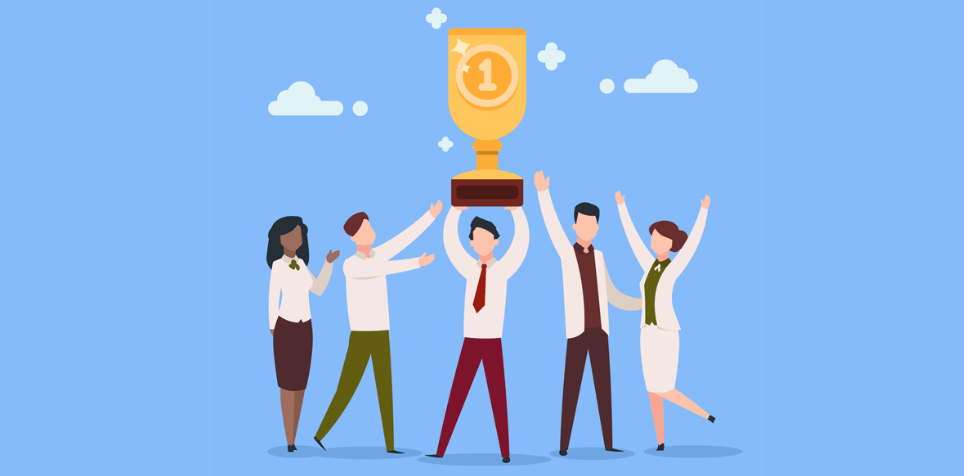
Where Should You Reward Employees?
Public Recognition
In team meetings or company-wide events. This not only celebrates the individual but also sets a benchmark for others.
Private Recognition
Some individuals prefer one-on-one acknowledgments. Understand the preferences of your employees.
Online Platforms
In the digital age, platforms like company intranets, newsletters, or even social media can be used to recognize employees.
Reward Events
Organizing events dedicated to celebrating achievements can be a great way to reward.
The Golden Apples of Appreciation: A Tale of Employee Rewards and Recognition at The Prestige Corp
The Prestige Corp, once a beacon of innovation and employee satisfaction, was facing a crisis. Employees felt undervalued, and productivity was at an all-time low. Management was puzzled: They paid competitive salaries, but morale was sinking.
The Unrecognized Talent: Jane, a dedicated programmer, worked late nights but felt invisible. A pat on the back or acknowledgment of her dedication was rare.
The Passionate Yet Disheartened Marketer: Mark had initiated multiple successful campaigns, but they went unnoticed. No bonuses, no accolades.
The Forgotten Administrative Hero: Sarah, the backbone of logistics and operations, efficiently managed her duties but felt her hard work was for naught.
Team Unity—A Lost Concept: The sales team, once a tightly knit group, now operates as mere colleagues rather than as a united force.
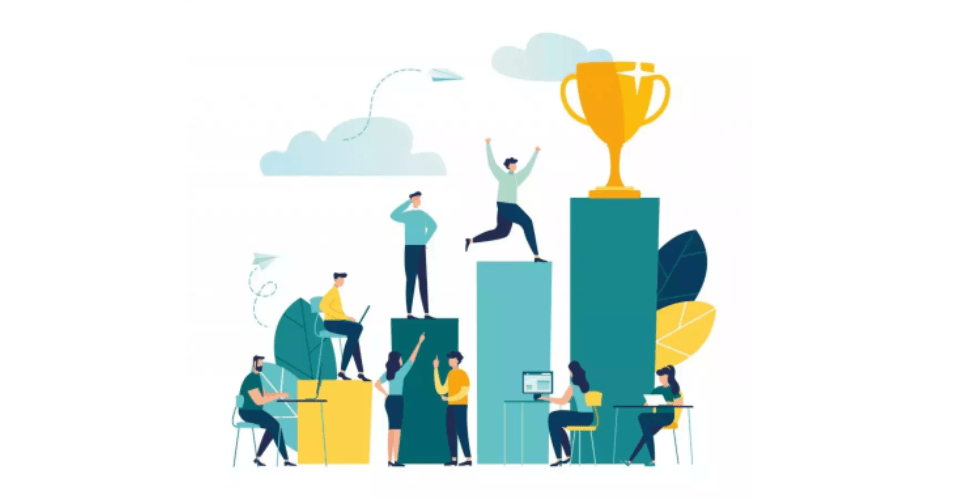
Understanding Reward Motivation Theory and Psychology
The psychology of motivation is vast, but the Reward Motivation theory is one of the most relatable and tangible concepts among its intricate web. At its core, it revolves around the idea that people are driven to act or behave in certain ways due to the rewards they anticipate receiving. This article aims to illuminate this fascinating concept, enriched with relevant examples and references.
Reward Motivation Psychology
Reward motivation psychology is rooted in the idea that rewards can significantly influence an individual’s behavior.
It posits that actions followed by positive outcomes will likely be repeated, given that they yield desirable results. Thus, in an organization, when employees associate their hard work, creativity, or initiative with rewards, they are more likely to replicate such behavior.
Intrinsic rewards, such as personal satisfaction and professional growth, and extrinsic rewards, such as bonuses and promotions, can significantly motivate employees. Striking the right balance between these rewards maximizes employee motivation and productivity.
Reward And Motivation Theory
Reward and motivation theory is an integral part of organizational psychology. The most prominent theories in this domain include Maslow’s Hierarchy of Needs, Herzberg’s Two-Factor Theory, and the Expectancy Theory.
- Maslow’s Hierarchy of Needs- Maslow’s Hierarchy of Needs states that employees have five levels of needs (physiological, safety, social, esteem, and self-actualization), and as each need is satisfied, the next becomes more significant. Therefore, rewards should be tailored to address these needs.
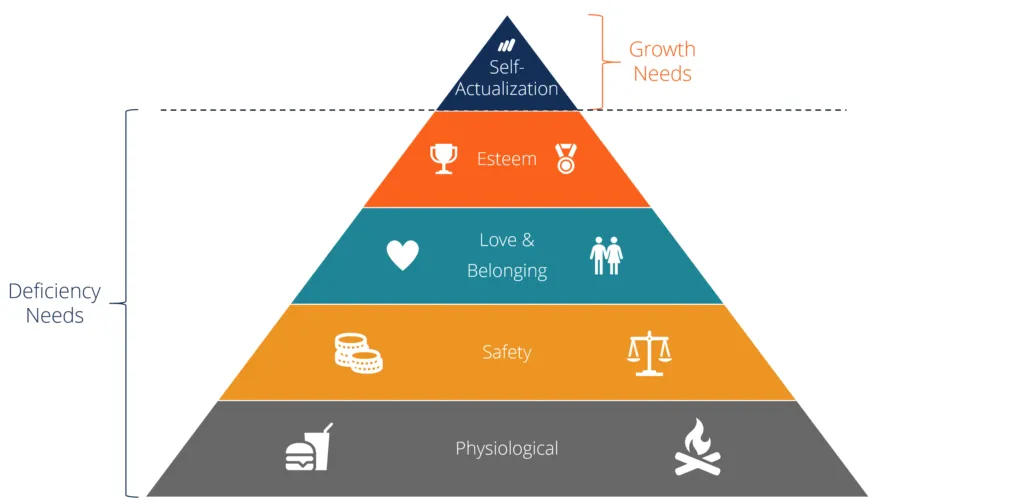
- Herzberg’s Two-Factor Theory- Herzberg’s Two-Factor Theory, on the other hand, distinguishes between factors that cause job satisfaction (motivators, e.g., challenging work, recognition, responsibility) and those that prevent job dissatisfaction (hygiene factors, e.g., company policy, supervision, salary). Hence, an effective reward system should encompass both motivators and hygiene factors.
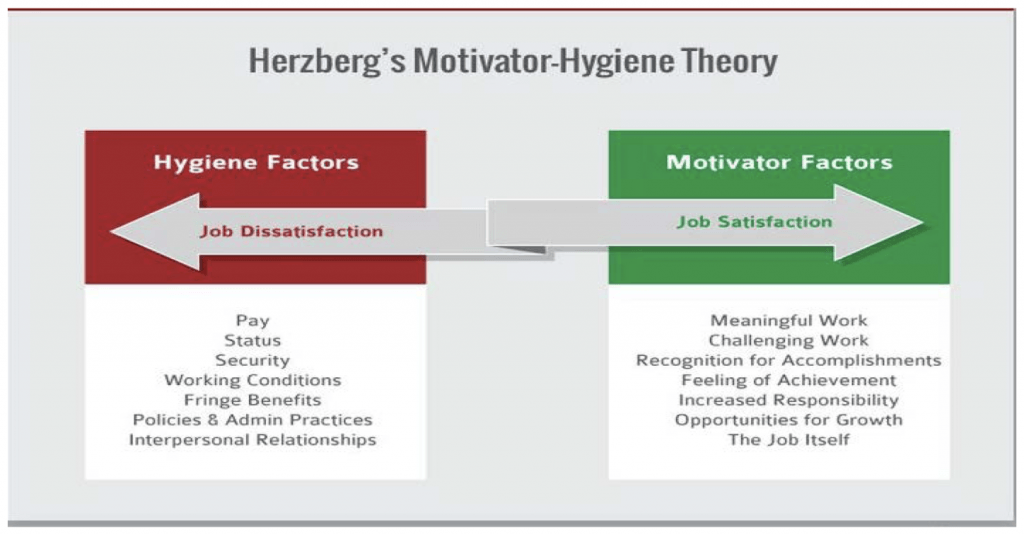
- Expectancy Theory- Finally, the Expectancy Theory posits that employees will be motivated if they believe that their efforts will lead to good performance, that good performance will be rewarded, and that they will find the reward value.

Key Concepts of Reward Motivation Theory
Intrinsic Rewards vs. Extrinsic Rewards
- Intrinsic rewards are intangible rewards that arise internally, such as personal satisfaction or a feeling of accomplishment.
- Extrinsic rewards refer to tangible rewards like bonuses, prizes, or promotions.
Immediate Rewards vs. Delayed Rewards
- Immediate rewards are those given instantly after a task is completed.
- Delayed rewards are deferred and are received after some time has passed.
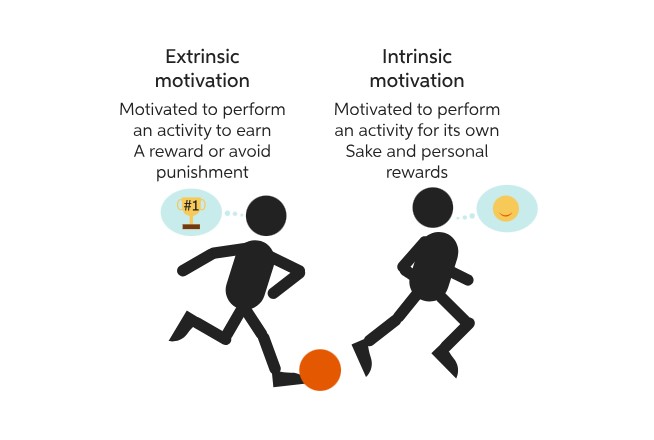
Examples of Reward Motivation
- In the Workplace: An employee works overtime to receive a bonus at the end of the month. This bonus acts as an extrinsic reward.
- In Education: A student studies hard to get praise from their parents and teachers (intrinsic reward), and possibly a scholarship (extrinsic reward).
- Health and Fitness: Someone hits the gym regularly to feel better about themselves (intrinsic reward) and to win a local fitness competition (extrinsic reward).
- Online Gaming: Players compete in a game to achieve personal satisfaction (intrinsic reward) and to possibly win in-game items or real-world prizes (extrinsic reward).
- Workplace Bonuses: Many companies offer bonuses to employees for achieving certain targets. This monetary incentive drives employees to work harder and achieve their goals.
- Gaming Achievements: Video games often provide rewards through points, badges, or levels. This keeps players engaged and motivated to progress further.
- Education and Grades: Expecting good grades can motivate students to study harder and perform better in exams.
- Personal Fitness Goals: The satisfaction of reaching a fitness milestone, losing weight or achieving a new personal best in a race, can be a strong motivator to continue training.
Importance and Benefits of Reward Motivation Theory
Understanding the Reward Motivation theory has several implications:
- For Employers: Recognizing that employees are motivated by salary and intrinsic rewards can help design comprehensive reward systems.
- For Educators, Recognizing the value of intrinsic and extrinsic rewards can help create a motivating learning environment.
- For Marketers, Tapping into the principles of reward motivation can help them design loyalty programs or promotional campaigns that resonate with consumers.
- For Employees:
- Enhanced Performance: When used correctly, rewards can significantly boost performance in quality and quantity.
- Over-reliance on Extrinsic Rewards: While extrinsic rewards can be powerful motivators, an over-reliance on them can diminish intrinsic motivation. When the external reward is removed, the individual may lose the drive to perform.
- Short-term vs. Long-term Goals: Reward motivation works best for short-term goals. For long-term objectives, intrinsic motivation – driven by personal values and passions – tends to be more sustainable.
- Risk of Unwanted Behavior: If incorrectly implemented, reward systems can inadvertently encourage undesired behavior. For example, if a company rewards employees solely based on quantity rather than quality, it might compromise the quality of work.
Reward Motivation theory offers a lens through which we can understand various human behaviors. By recognizing the power of both intrinsic and extrinsic rewards, we can design strategies in various domains, from businesses to education, that can harness this understanding to produce desired outcomes.
Humans are constantly driven by various motives to achieve our goals. Among these motives, reward plays a central role. Reward motivation is deeply embedded in our psychology, driving us to perform actions that bring pleasure, satisfaction, or a sense of accomplishment.
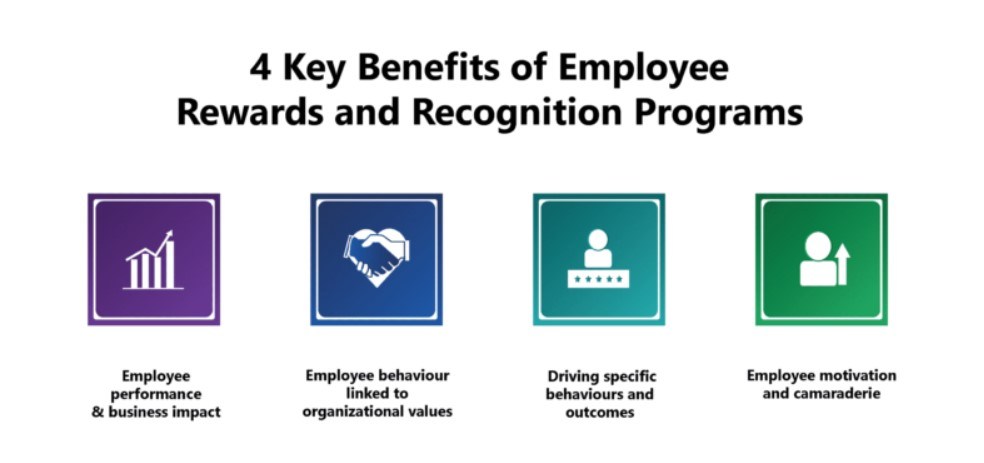
Difference Between Rewards and Recognition
Rewards and recognition programs systematically acknowledge and incentivize employees’ performance and behaviors. They encompass a range of practices, from formal annual award ceremonies to spontaneous day-to-day acknowledgments. Understanding the important differences between these approaches helps ensure that structured rewards and informal recognition are effectively integrated into your employee engagement strategy.
| Aspect | Rewards | Recognition |
|---|---|---|
| Definition | Tangible or monetary gifts for specific milestones, results, or behaviors. | Intangible acknowledgment of contributions and efforts. |
| Examples | Bonuses, gift cards, new laptops, holiday packages. | ‘Thank you’ emails, mentions in meetings, Employee of the Month. |
| Nature | Tangible and often monetary. | Intangible and verbal or written. |
| Frequency | Typically structured and formal, such as annual bonuses or milestone awards. | It can be spontaneous and informal, like daily or weekly acknowledgments. |
| Market Component | Often involves a marketplace where rewards can be redeemed. | Does not involve a marketplace or physical exchange. |
| Purpose | To incentivize and motivate employees through material benefits. | Appreciate and value ongoing contributions that align with the company’s mission. |
| Impact | Directly tied to performance metrics and milestones. | Focuses on daily contributions and creates a culture of appreciation. |
| Use in Organization | Part of a structured reward system to retain and motivate talent. | Part of fostering a positive work environment and boosting morale. |
While rewards offer tangible benefits that directly impact performance and motivation, recognition doesn’t always involve a physical component but plays a crucial role in appreciating daily efforts and aligning with the organization’s values. Balancing both approaches is essential for creating a comprehensive employee engagement strategy. It’s a great way to ensure every employee feels valued and motivated.

Employee Rewards and Recognition Programs
Few strategies can compare to the impact of a well-executed rewards and recognition program on boosting employee morale, engagement, and loyalty. Beyond monetary compensation, these programs can foster a culture of appreciation, enhance employee satisfaction, and drive performance.
Employee of the Month
The Employee of the Month program is a classic and effective approach to highlight and reward outstanding performance. Each month, exemplary employees are recognized for their contributions, showcasing their dedication and hard work. This recognition not only boosts individual morale but also motivates other employees. Celebrating these achievements regularly gives employees something to strive for and reinforces the value of their individual contributions. Being named Employee of the Month can be celebrated with a special gift or a feature in the company newsletter, making employees feel valued and appreciated.
Spot Awards
Spot awards are spontaneous rewards given to employees who go above and beyond their usual duties. Whether a gift card, a small bonus, or a special token, these immediate rewards provide instant recognition for exceptional work. Using mobile-friendly platforms or apps, you can make it easy for managers and peers to give employees these rewards on the spot. Spot awards help to create a culture where exceptional performance is quickly acknowledged, encouraging a sense of accomplishment and further engagement.
Peer-to-Peer Recognition
Peer-to-peer recognition programs allow employees to acknowledge and appreciate each other’s efforts. Employees can send virtual ‘kudos’ or ‘high-fives’ to their colleagues by implementing AI-powered or mobile-friendly platforms. This approach not only fosters team spirit but also ensures that recognition comes from multiple sources, enhancing the impact of the appreciation. Building a system where employees regularly recognize each other’s achievements helps create a supportive workplace culture where everyone feels valued.
Service Awards
Service awards celebrate employee loyalty and long-term commitment to the company. Recognizing milestones such as work anniversaries or years of service with a sabbatical, special gift, or a birthday celebration provides meaningful acknowledgment of an employee’s dedication. These awards show that you value their long-term contributions and help reinforce their role as company ambassadors. Such gestures also make employees love to see their commitment recognized, enhancing overall job satisfaction.
Training and Development Opportunities
Offering training and development opportunities as rewards is a fantastic way to invest in your top performers. Providing access to workshops, courses, or funding for higher education helps employees expand their skills and advance their careers. This rewards individual contributions and shows a commitment to their professional growth. Creating a program that offers these opportunities helps motivate employees and can lead to enhanced performance and greater loyalty.
Health and Wellness Rewards
Health and wellness rewards support employees in maintaining a healthy lifestyle, which is crucial for overall well-being and productivity. Offering gym memberships, wellness retreats, or health insurance discounts as part of your rewards program encourages employees to prioritize their health. These rewards also contribute to a positive work environment and help reduce stress, leading to improved engagement and job satisfaction. Regularly providing such wellness benefits shows that you care about employees’ holistic well-being.
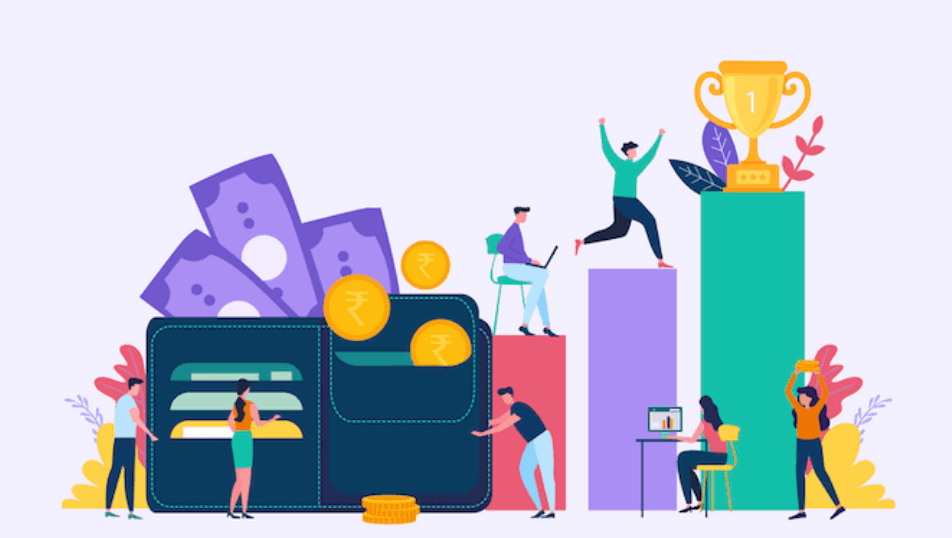
Reward and Recognition Ideas For Employees To Boost Morale and Motivate
Employee reward ideas can be both monetary and non-monetary. While monetary rewards, such as bonuses and raises, are powerful motivators, non-monetary rewards can also significantly impact employee motivation and satisfaction.
Recognition and Appreciation
- Personalized thank-you notes or letters highlighting specific achievements.
- Public recognition during team meetings or company-wide announcements.
- Employee spotlights on the company’s intranet or newsletter.
Professional Development Opportunities
- Sponsorship for conferences, workshops, or industry events.
- Funding for professional certifications or courses.
- One-on-one coaching or mentoring sessions with senior leaders.
Flexible Work Arrangements
- Allowing employees to work remotely or have flexible working hours.
- Offering compressed workweeks or alternative schedules.
- Implementing a results-driven work culture that focuses on outcomes rather than strict hours.
Additional Time Off
- Extra vacation days or a “work-free” day for exceptional performance.
- Extended weekends or long weekends as a reward for meeting targets.
- Sabbatical leave or extended time off for long-serving employees.
Monetary Rewards
- Performance-based bonuses or profit-sharing programs.
- Gift cards to popular retailers, restaurants, or online platforms.
- Cash rewards or monetary incentives for achieving significant milestones or targets.
Wellness Initiatives
- Subsidized gym memberships or wellness program enrollment.
- On-site yoga or fitness classes during work hours.
- Employee assistance programs offering counseling or mental health support.
Team-Building Activities
- Organizing off-site team-building retreats or workshops.
- Team lunches or dinners at a local restaurant.
- Fun and engaging team-building games or activities during work hours.
Personalized Gifts
- Customized company-branded merchandise such as clothing or accessories.
- Engraved plaques or trophies to commemorate achievements.
- Personalized gifts tailored to each employee’s interests or hobbies.
Special Projects or Assignments
- Allowing employees to take on challenging projects or initiatives of interest.
- Providing opportunities for cross-functional collaboration or departmental rotations.
- Assigning leadership roles in company-wide initiatives or committees.
Employee Perks
- Upgraded office equipment or technology.
- Free or discounted services from partner companies (e.g., gym memberships, travel discounts).
- Access to exclusive employee lounges, relaxation areas, or recreational facilities.
SwagMagic specializes in corporate and employee gifting, providing a wide range of high-quality, personalized products that can serve as excellent non-monetary rewards. These range from branded office supplies and apparel to unique gadgets and wellness products.
These SwagMagic gifts serve as tokens of appreciation and help strengthen the company’s brand identity. Employees who use these products are constantly reminded of their affiliation with the company, fostering a sense of belonging and pride.
Moreover, gifting personalized items from SwagMagic to employees can make them feel valued and appreciated as individuals, not just as workers. This personalized touch can enhance employee satisfaction and loyalty, motivating them to strive for excellence.
Some creative non-monetary employee recognition ideas include flexible working hours, additional vacation days, training opportunities, or a simple thank you note. SwagMagic can supplement these rewards by providing personalized gifts catering to each employee’s unique preferences and needs.
Low-cost rewards for employees can also be highly motivating. For example, a personalized thank-you note, public recognition in a team meeting, or a small token of appreciation, like a gift card or a book, can make employees feel valued and appreciated. In addition to these, SwagMagic offers a variety of budget-friendly options that can serve as impactful rewards.
Rewarding employees for good performance motivates them to maintain their performance and sets a positive example for other employees, encouraging them to strive for excellence. With SwagMagic’s diverse product range, companies can find the perfect gifts to reward and motivate their employees.

Importance and Benefits of Employee Rewards and Recognition Programs
- Boosts Morale: Recognizing efforts makes employees feel valued, increasing satisfaction and enthusiasm in their roles.
- Enhances Performance: When employees know their hard work is noticed and appreciated, they are more likely to put in extra effort.
- Retains Talent: A sense of being appreciated reduces turnover rates, as employees feel a stronger connection to the company.
- Promotes Desired Behaviors: By aligning rewards and recognition with company goals, businesses can drive specific behaviors, such as teamwork, innovation, or customer service.
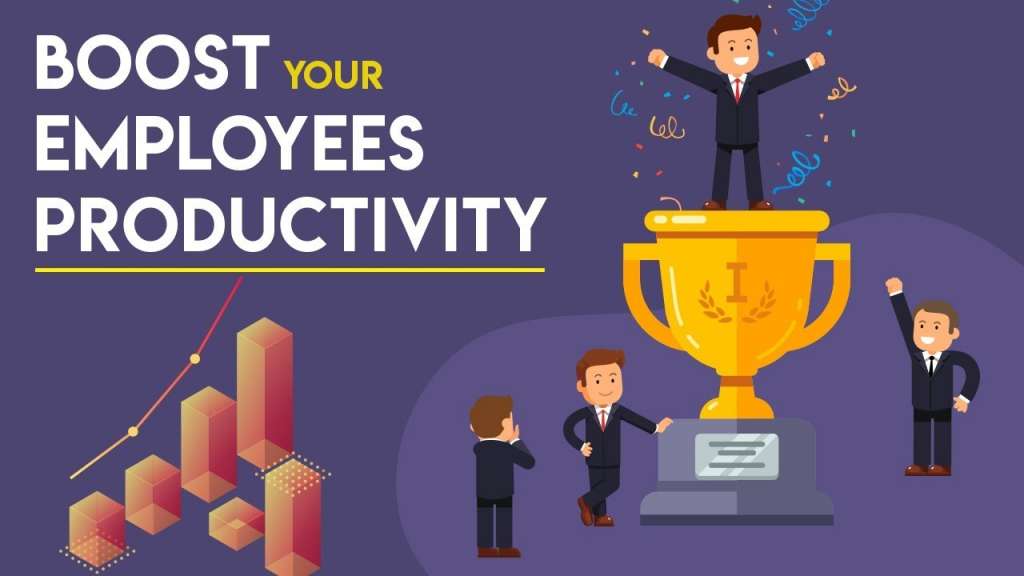
How to Announce Employee Reward and Recognition at the Workplace
Announcing rewards and recognition in the workplace can boost morale, motivation, and engagement. Here’s how you can make the announcement effective and inspiring:
Choose the Right Medium
- In-person: Organize a team meeting or an all-hands meeting. This allows for immediate celebration and acknowledgment.
- Email: Send out a company-wide or department-specific email.
- Newsletter: If your company circulates a periodic newsletter, include a special section for recognition.
- Bulletin Boards: Utilize physical or digital boards to highlight achievements.
- Company Intranet or Social Media: The awardee can share the news on internal communication platforms or even company social media channels, provided they are comfortable with public acknowledgment.
Make it Personal
- Personalize the Announcement: Always mention the person’s name, role, and specific achievement.
- Tell a Story: Briefly narrate what led to the achievement, how they contributed, or any challenges they overcame.
Add Visual Elements
- Include a photo of the awardee or a visual representation of their achievement.
- If digital, consider adding graphics, GIFs, or even video clips to make the announcement more engaging.
Give Specific Details
- Clearly state why the person is being recognized. Was it for a project well done? Consistent performance? Going above and beyond in a specific instance?
- Mention the impact of their achievement on the team or company at large.
Include an Appreciation Quote
- Include an appreciation quote from a manager, colleague, or client praising the individual’s effort. It adds authenticity and depth to the recognition.
Encourage Others to Join In
- Prompt team members to share their own words of appreciation. This can be in the form of comments on a post, emails, or verbal praises during meetings.
Pair with Tangible Rewards
- If the recognition comes with a tangible reward (like a bonus, certificate, or gift), mention it in the announcement.
- However, always ensure that the focus is on the achievement and not just the reward.
Reiterate Company Values
- Align the achievement with company values or goals, illustrating how the recognized individual embodies the ethos of the organization.
Keep it Regular
- Ensure that recognition isn’t a one-off event. Regularly acknowledge and reward deserving employees, even for small wins.
Invite Feedback
- Encourage employees to suggest peers who they feel deserve recognition in the future. This promotes a culture of appreciation and acknowledgment.
By recognizing employees in a structured and heartfelt manner, companies can foster a positive workplace environment and motivate others to strive for excellence.
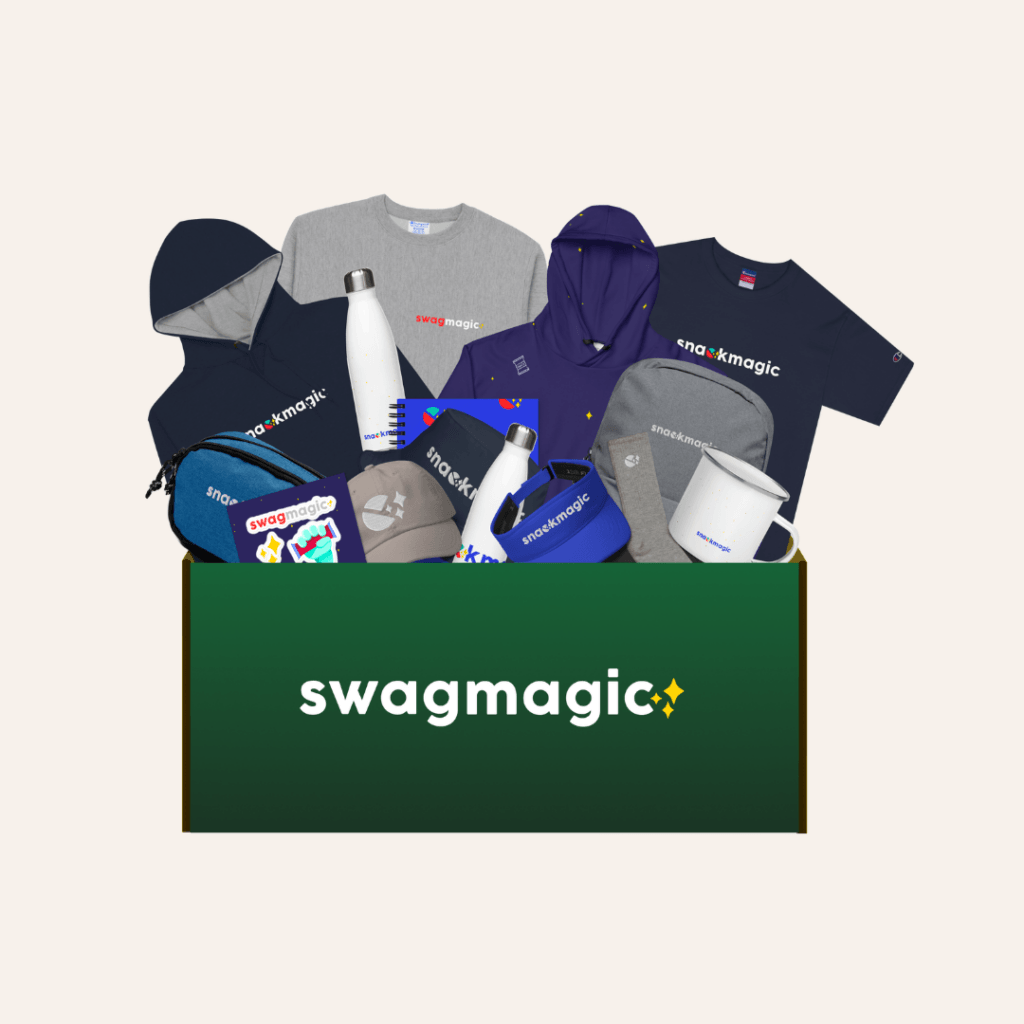
Companies with Best Employee Rewards and Recognition Programs
Employee recognition has become increasingly important as companies recognize the value of appreciating their workforce and the positive impacts such appreciation can have on employee morale, productivity, and retention. Some companies are renowned for their outstanding employee recognition programs, while others leverage platforms or services like SwagMagic, SnackMagic, and Stadium to bolster their initiatives.
- Google: Google is renowned for its work culture. The tech giant provides its employees with a host of perks and benefits and ensures that they are recognized and rewarded for their achievements. Google uses peer recognition, financial bonuses, and other recognition systems.
- Salesforce: Salesforce has a comprehensive recognition program that uses monetary and non-monetary rewards. Employees can give each other “Chatter” compliments on the internal social network, and top performers are sometimes treated to trips or special experiences.
- Adobe: Instead of traditional performance reviews, Adobe uses a “Check-in” system, allowing managers and their direct reports to have continuous conversations about objectives and expectations. This allows for real-time recognition and feedback.
- Zappos: Zappos has an interesting peer-to-peer recognition program. Employees can award one another with “Zollars” (Zappos dollars) for good work, which can be used to purchase items from the Zappos gift shop.
Best Reward and Recognition Platform Offering Employee Rewards Ideas and Employee Recognition Services
Companies like SwagMagic, SnackMagic, and Stadium bring a unique spin to employee recognition.
SwagMagic
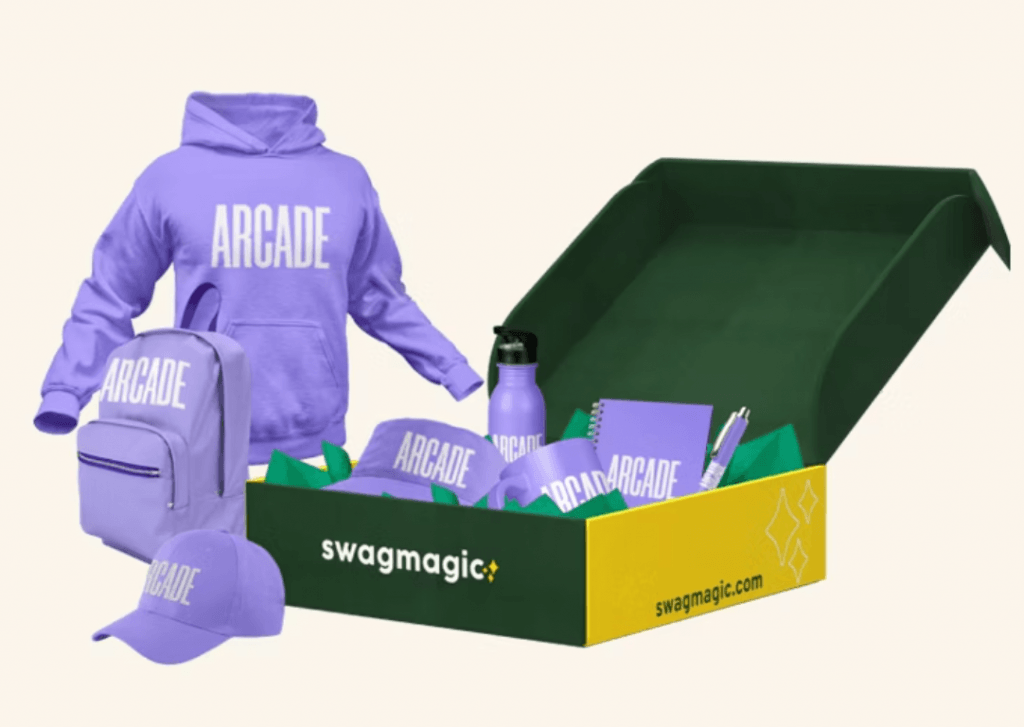
This platform offers custom swag options. Companies can utilize SwagMagic to create branded merchandise that’s used as part of a recognition program. Recognizing an employee’s hard work with a custom-made item can make them feel valued and special.
SnackMagic
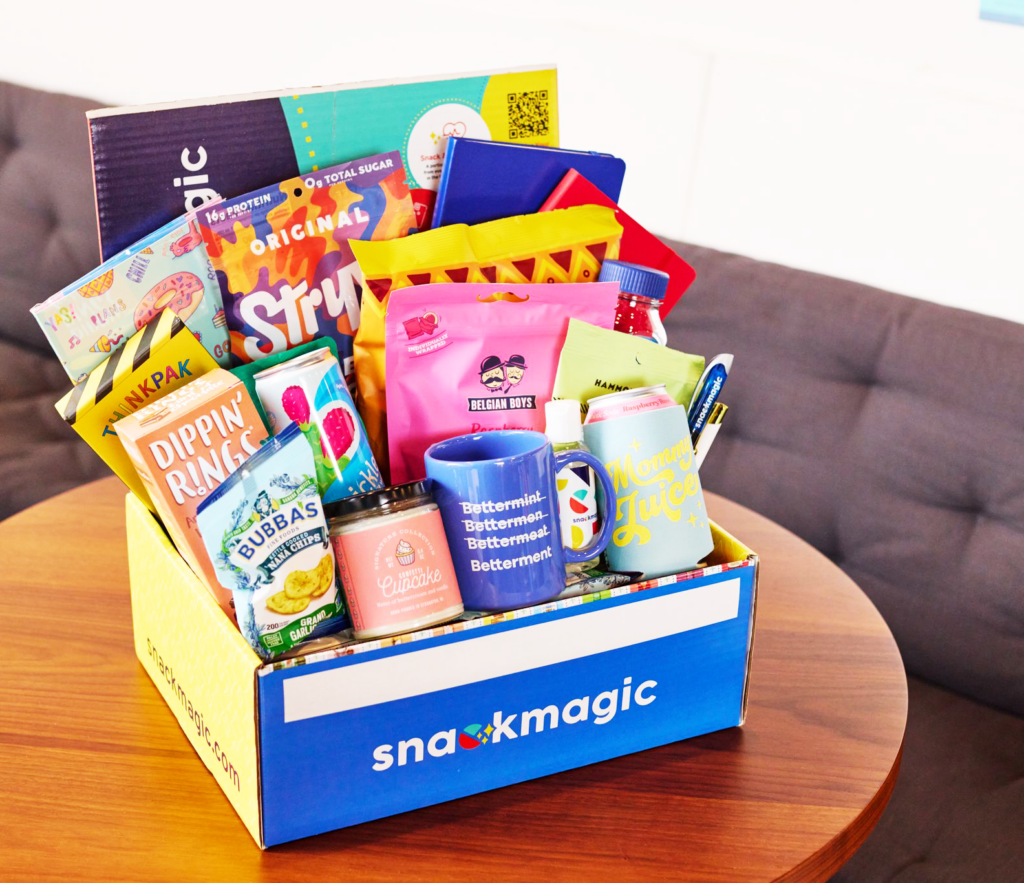
Recognizing that everyone loves snacks, SnackMagic allows companies to send personalized snack boxes to their employees. These boxes can be used to recognize special achievements or milestones or simply boost morale. The option to customize the content ensures that employees get something they truly enjoy.
Stadium
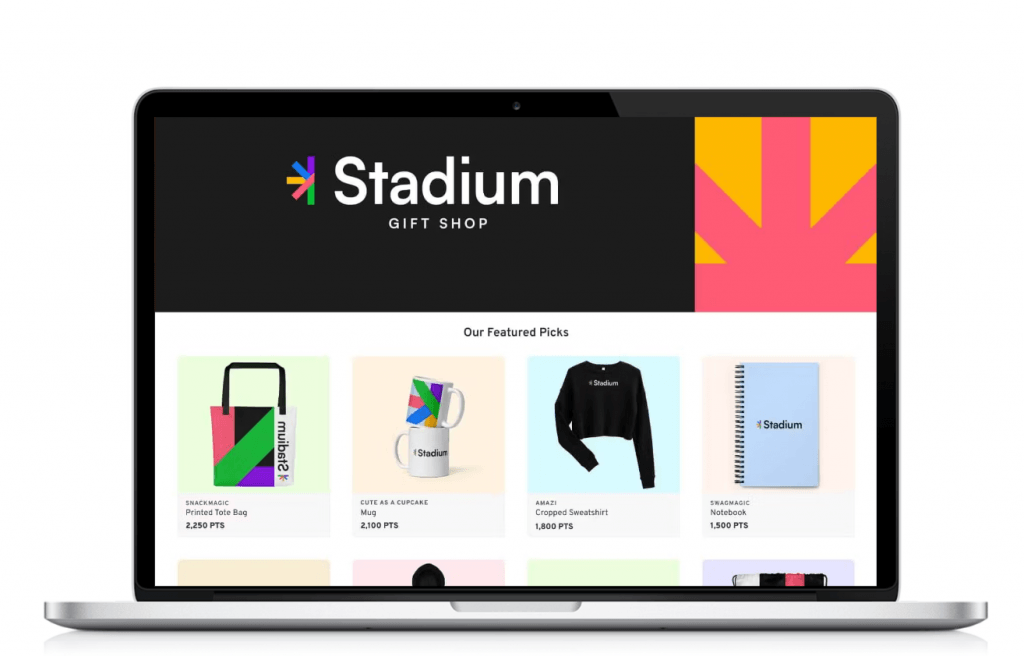
This platform focuses on group food orders, making it easy for companies to treat their teams to meals from various restaurants. Celebrating team achievements or milestones with a special lunch or dinner can effectively recognize hard work.
Addressing Pain Points of Employee Rewards and Recognition with SwagMagic Offerings
- The Unrecognized Talent:
- Pain Point: Jane’s consistent hard work goes unnoticed, making her feel undervalued.
- SwagMagic Solution: Custom and Personalized Swag such as a tailored T-shirt or notebook engraved with a special message like “Jane – The Code Magician” can make her feel singled out and appreciated for her unique contribution.
- The Passionate Yet Disheartened Marketer:
- Pain Point: Mark’s successful campaigns don’t earn him recognition.
- SwagMagic Solution: Promotional Merchandise tailored to represent his specific campaigns can serve as tangible evidence of his achievements. For instance, a campaign-specific keychain or badge can act as a constant reminder of his accomplishments.
- The Forgotten Administrative Hero:
- Pain Point: Sarah feels that her daily contributions are taken for granted.
- SwagMagic Solution: Gift Card Solutions can give Sarah the freedom to choose her own rewards, reflecting a personal touch in appreciation and acknowledging her value.
- Team Unity – A Lost Concept:
- Pain Point: The once-united sales team no longer feels a sense of camaraderie.
- SwagMagic Solution: A Swag Store can be a place for the team to pick collective rewards, fostering a sense of unity. Corporate Gifting Solutions for team anniversaries or milestones can reinforce the team spirit.
- Monetary Bonuses Aren’t Always Enough:
- Pain Point: Cash can seem impersonal and does not always resonate emotionally.
- SwagMagic Solution: Custom and Personalized Swag offers a personal touch, turning a generic reward into something memorable and emotionally resonant.
- Lack of Tangible Recognition:
- Pain Point: Verbal appreciations are fleeting and can be quickly forgotten.
- SwagMagic Solution: Promotional Merchandise provides a tangible and lasting acknowledgment of an employee’s contributions, serving as a physical reminder of their value.
- Team Achievements Go Uncelebrated:
- Pain Point: Without acknowledgment, team achievements can feel meaningless.
- SwagMagic Solution: Corporate Gifting Solutions can provide team-wide rewards, celebrating collective milestones and promoting unity. Offering team-oriented merchandise or experiences ensures everyone feels valued for their collective effort.
SwagMagic’s diverse offerings address the core issue of feeling unrecognized and unappreciated. Their solutions provide tangible rewards and infuse employees with a sense of belonging, recognition, and camaraderie.
References:
- Deci, E. L., & Ryan, R. M. (1985). Intrinsic motivation and self-determination in human behavior. New York: Plenum.
- Pink, D. H. (2009). Drive: The surprising truth about what motivates us. Riverhead Books.
- Deci, E. L., & Ryan, R. M. (1985). Intrinsic motivation and self-determination in human behavior. New York: Plenum.
- Lepper, M. R., & Greene, D. (1978). The hidden costs of reward: New perspectives on the psychology of human motivation. Lawrence Erlbaum.
- Bersin by Deloitte (2016). “The Employee Recognition Maturity Model.” This research provides insights into how mature organizations develop recognition strategies.
- Gallup (2017). “State of the American Workplace.” This report highlights the importance of employee recognition in retention and engagement.
- Grant, A.M. (2013). “Give and Take: A Revolutionary Approach to Success.” This book emphasizes the power of recognition in the workplace and how it can drive success.
- Pink, D.H. (2009). “Drive: The Surprising Truth About What Motivates Us.” A deep dive into human motivation and how rewards can be effectively used to drive performance.

Leave a Comment